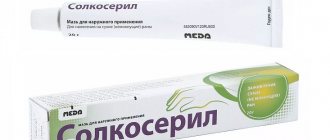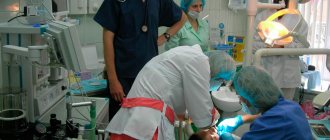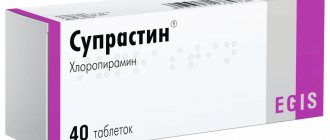Composition and release form
| Injection | 1 ml |
| deproteinized dialysate from the blood of healthy dairy calves, standardized chemically and biologically (in terms of dry matter) | 42.5 mg |
| excipients: water for injection - up to 1 ml |
in ampoules of 2 ml; there are 25 ampoules in a box; or in ampoules of 5 and 10 ml; There are 5 ampoules in a box.
| Gel | 1 g |
| deproteinized dialysate from the blood of healthy dairy calves, standardized chemically and biologically (in terms of dry matter) | 4.15 mg |
| preservatives: methyl parahydroxybenzoate (E218) and propyl parahydroxybenzoate (E216) | |
| excipients: calcium lactate; sodium carboxymethylcellulose; propylene glycol; water for injections |
in tubes of 20 g; 1 tube in a box.
| Ointment | 1 g |
| deproteinized dialysate from the blood of healthy dairy calves, standardized chemically and biologically (in terms of dry matter) | 2.07 mg |
| preservatives: methyl parahydroxybenzoate (E218) and propyl parahydroxybenzoate (E216) | |
| excipients: cetyl alcohol; cholesterol; white Vaseline; water for injections |
in tubes of 20 g; 1 tube in a box.
pharmachologic effect
Pharmacological action - wound healing, angioprotective, membrane stabilizing, regenerating, cytoprotective, antihypoxic.
The drug Solcoseryl is a deproteinized hemodialysate containing a wide range of low-molecular components of cell mass and blood serum of dairy calves with a molecular weight of 5000 D, the properties of which are currently only partially studied by chemical and pharmacological methods.
In in vitro tests, as well as during preclinical and clinical studies, it was found that Solcoseryl:
— increases reparative and regenerative processes;
— promotes activation of aerobic metabolic processes and oxidative phosphorylation;
— increases oxygen consumption in vitro and stimulates glucose transport into cells under hypoxic conditions and into metabolically depleted cells;
— increases collagen synthesis (in vitro);
— stimulates cell proliferation and migration (in vitro).
Solcoseryl gel does not contain fats as auxiliary components, making it easy to wash off. Promotes the formation of granulation tissue and the elimination of exudate.
From the moment fresh granulations appear and the wound dries, it is recommended to use Solcoseryl ointment, which contains fats as auxiliary components and forms a protective film on the wound surface.
Pharmacological properties
Pharmacodynamics. solcoseryl is a deproteinized hemoderivative from the blood of calves, obtained by dialysis and ultrafiltration, with a wide range of natural low-molecular substances with a molecular weight of 5000 yes, only some of which are described chemically and pharmacologically. in in vitro tests, as well as during preclinical and clinical studies, it was revealed that solcoseryl:
- supports aerobic metabolism and oxidative phosphorylation, and also promotes the replenishment of high-energy phosphates in cells that do not receive sufficient nutrition;
- increases in vitro oxygen utilization and glucose transport into tissues and cells that suffer from hypoxia and are metabolically depleted;
- improves the processes of repair and regeneration of damaged tissues with insufficient nutrition;
- prevents or reduces secondary degradation and pathological changes in reversibly damaged cellular systems;
- accelerates collagen synthesis in in vitro models;
- stimulates cell proliferation and migration in vitro.
Thus, Solcoseryl has a protective effect against tissues in a state of hypoxia and nutritional deficiency, promotes their regeneration, and accelerates wound healing.
Pharmacokinetics. The absorption, distribution and elimination of the active component of the drug Solcoseryl, a deproteinized standardized hemoderivative, cannot be studied by conventional pharmacokinetic methods, such as radioactive labeling and others, since the protein-free hemoderivative contains a mixture of different molecules with different physicochemical properties.
In the process of studying pharmacokinetics in animals, it was revealed that the effect of the drug develops 20 minutes (10–30 minutes) after a parenteral bolus injection, its effect persists for 3 hours after administration.
In patients with liver and kidney failure and with age-related metabolic changes, no effect on the action of Solcoseryl has been identified to date. It is not known how the active substances cross the placenta or into breast milk.
Indications for the drug Solcoseryl
Solcoseryl solution for injection.
Occlusive diseases of peripheral arteries in stages III–IV according to Fontaine in patients with contraindications/intolerance to other medications;
chronic venous insufficiency, accompanied by trophic disorders (Ulcera cruris), in cases of their persistent course;
disorders of cerebral metabolism and blood circulation (ischemic and hemorrhagic stroke, traumatic brain injury).
Solcoseryl gel, ointment.
Minor damage (abrasions, scratches, cuts).
1st and 2nd degree burns (sunburn, thermal burns).
Frostbite.
Difficult-to-heal wounds (including trophic ulcers and bedsores).
Contraindications
Solcoseryl solution for injection.
Established hypersensitivity to calf blood dialysates;
since Solcoseryl injection contains derivatives of parahydroxybenzoic acid (E216 and E218), used as preservatives, as well as trace amounts of free benzoic acid (E210), the drug should not be used if there is an allergic reaction to the listed components;
There are no data on the safety of Solcoseryl injection in children, so the drug should not be prescribed to children under 18 years of age;
Solcoseryl injections should not be mixed when administered with other drugs, with the exception of isotonic sodium chloride solution and 5% glucose solution.
Solcoseryl gel, ointment.
Hypersensitivity to one of the components of the drug.
Use with caution if you are predisposed to allergic reactions.
Solcoseryl solution d/iv and intramuscular injection 42.5 mg/ml 5 ml No. 5
Additional information: Drug type medicinal product
Pharmacological group : a drug that activates metabolism in tissues, improves trophism and stimulates the regeneration process
Prescription drug yes
Active ingredient : deproteinized dialysate from the blood of healthy dairy calves
Release form solution for intravenous and intramuscular administration
Volume 5
Area of application in cardiovascular diseases
Pharmacological action: wound healing, angioprotective, membrane stabilizing, regenerating, cytoprotective, antihypoxic
Indications for use : disorders of peripheral arterial or venous circulation: occlusive diseases of peripheral arteries in stages III-IV according to Fontaine; chronic venous insufficiency, accompanied by trophic disorders; disorders of cerebral metabolism and blood circulation: ischemic stroke; hemorrhagic stroke; traumatic brain injuries
Composition 1 ml contains: active substance: deproteinized dialysate from the blood of healthy dairy calves (in terms of dry matter) (42.5 mg); excipients: water for
Interaction should be used with caution simultaneously with drugs that increase the level of potassium in the blood (potassium supplements, potassium-sparing diuretics, ACE inhibitors); the drug should not be mixed when administered with other drugs (especially with phytoextracts); the drug is incompatible with parenteral forms of Ginkgo biloba, naftidrofuril and bencyclane fumarate
Contraindications: children and adolescents under 18 years of age (no data on safety of use); pregnancy (no safety data available); lactation (no data on safety of use); established hypersensitivity to calf blood dialysates; hypersensitivity to parahydroxybenzoic acid derivatives (E216 and E218) and to free benzoic acid (E210); the drug should be used with caution in case of hyperkalemia, renal failure, cardiac arrhythmias, concomitant use of potassium supplements (since Solcoseryl contains potassium), oliguria, anuria, pulmonary edema, severe heart failure
Dosage IV drip (previously diluted with 250 ml of 0.9% sodium chloride solution or 5% dextrose solution), slowly IV (previously diluted with 0.9% sodium chloride solution or 5% dextrose solution in a ratio of 1:1) or intramuscularly; occlusive diseases of peripheral arteries in stage III-IV according to Fontaine: iv 20 ml daily, duration of therapy is up to 4 weeks and is determined by the clinical picture of the disease; chronic venous insufficiency, accompanied by trophic disorders: 10 ml IV 3 times a week; the duration of therapy is no more than 4 weeks and is determined by the clinical picture of the disease; traumatic brain injury, metabolic and vascular diseases of the brain: IV 10-20 ml daily for 10 days, then IM or IV 2 ml for up to 30 days; if intravenous administration is not possible, the drug can be administered intramuscularly at 2 ml/day
Use during pregnancy is contraindicated
Side effects : allergic reactions: rarely - urticaria, increased body temperature; local reactions: rarely - hyperemia, swelling at the injection site
Overdose No cases of overdose have been reported
Storage conditions: Store out of reach of children, protected from light at a temperature not exceeding 25°C.
Special instructions: in case of adverse reactions, you should stop using the drug and prescribe symptomatic therapy
Side effects
Solcoseryl solution for injection.
In rare cases, allergic reactions may develop (urticaria, hyperemia and swelling at the injection site, increased body temperature). In this case, it is necessary to stop using the drug and prescribe symptomatic treatment.
Solcoseryl gel, ointment.
In rare cases, allergic reactions in the form of urticaria and marginal dermatitis may develop at the site of application of Solcoseryl. In this case, you must stop using the drug and consult a doctor.
A short-term burning sensation may be observed at the site of application of Solcoseryl gel. If the burning sensation does not go away for a long time, the use of Solcoseryl gel should be abandoned.
Interaction
Solcoseryl injections should not be mixed when administered with other medications, especially with phytoextracts.
The pharmaceutical incompatibility of Solcoseryl in the form of an injection solution with parenteral forms has been established:
Ginkgo biloba extract,
naftidrofuryl,
bencyclane fumarate.
As solutions for diluting Solcoseryl injection, only isotonic sodium chloride solution and 5% glucose solution should be used.
The interaction of Solcoseryl with other topical medications has not been established.
Directions for use and doses
Solcoseryl injection solution: intravenous or intramuscular.
In the treatment of occlusive diseases of peripheral arteries in stages III–IV according to Fontaine - 20 ml intravenously daily. Intravenous drip administration in isotonic sodium chloride solution or 5% glucose solution is possible. The duration of therapy is up to 4 weeks and is determined by the clinical picture of the disease.
In the treatment of chronic venous insufficiency accompanied by trophic disorders (Ulcera cruris) - 10 ml intravenously 3 times a week. The duration of therapy is no more than 4 weeks and is determined by the clinical picture of the disease. An important additional measure aimed at preventing peripheral “venous” edema is the application of a pressure bandage using an elastic bandage.
In the presence of local trophic tissue disorders, simultaneous therapy with Solcoseryl jelly and then Solcoseryl ointment is recommended.
In the treatment of ischemic and hemorrhagic strokes in severe and extremely severe forms, the main course is 10 or 20 ml intravenously, respectively, daily for 10 days. Upon completion of the main course - 2 ml intramuscularly or intravenously for 30 days.
Traumatic brain injury (severe brain contusion) - 1000 mg intravenously, daily for 5 days.
If intravenous administration of the drug is not possible, the drug can be administered intramuscularly, usually 2 ml per day undiluted.
When using the undiluted drug intravenously, it must be administered slowly, since it is a hypertonic solution.
Solcoseryl gel, ointment: topically.
Apply directly to the wound surface after preliminary cleansing of the wound using a disinfectant solution.
Before starting treatment of trophic ulcers, as well as in cases of purulent infection of the wound, preliminary surgical treatment is necessary.
Solcoseryl gel is applied to fresh wounds, wounds with wet discharge, and to ulcers with signs of weeping - a thin layer on a cleaned wound 2-3 times a day. It is recommended to lubricate areas where epithelization has begun with Solcoseryl ointment. The use of Solcoseryl gel continues until pronounced granulation tissue forms on the damaged skin surface and the wound dries out.
Solcoseryl ointment is used primarily for the treatment of dry (non-wetting) wounds.
Solcoseryl ointment is applied in a thin layer to a cleaned wound 1-2 times a day; it can be used under bandages. The course of treatment with Solcoseryl ointment continues until the wound is completely healed, its epithelization and the formation of elastic scar tissue.
For the treatment of severe trophic damage to the skin and soft tissues, the simultaneous use of parenteral forms of Solcoseryl is recommended.
Application
If the clinical condition of the patient allows, the drug should, if possible, be used in the form of a solution for injection of solcoseryl in a dilution of at least 1:1 with a physiological solution or glucose solution. Solcoseryl injection solution should be administered slowly in the form of intravenous injections or infusions.
The IV injection of the solution must be carried out slowly over 2 minutes in order to reduce the possibility of rapid administration of potassium.
The volume of the injection solution should not exceed 40 ml.
For IV infusion, if the total volume of the solution exceeds 40 ml, the infusion rate depends on the hemodynamic status of the patient.
Solcoseryl should not be diluted in potassium-containing solutions for infusion. There is no experience in using and studying the safety of the drug in the treatment of children and adolescents under 18 years of age.
The following dosage is recommended:
- occlusive disease of peripheral arteries (III–IV degrees according to Fontaine): 850 mg of Solcoseryl (equivalent to 20 ml of undiluted solution) daily i.v. Typically, the duration of use is up to 4 weeks and depends on the clinical picture;
- chronic venous insufficiency with treatment-resistant trophic ulcers of the legs: 425 mg Solcoseryl (equivalent to 10 ml of undiluted solution) IV 3 times a week. Typically, the course of treatment lasts 4 weeks and depends on the course of the disease.
special instructions
Solcoseryl (gel, ointment) should not be applied to a contaminated wound, since it does not contain antimicrobial components.
The use of Solcoseryl, like all other medications, is undesirable during pregnancy and breastfeeding and is possible only when absolutely necessary and under the supervision of a doctor.
If you experience pain, redness of the skin near the site where Solcoseryl was applied, secretion from the wound, or increased body temperature, you should immediately consult a doctor.
If, when using Solcoseryl, healing of the affected area is not observed within 2-3 weeks, you should consult a doctor.
Note!
Description of the drug Solcoseryl solution d/in. amp. 5ml No. 5 on this page is a simplified author’s version of the apteka911 website, created on the basis of the instructions for use.
Before purchasing or using the drug, you should consult your doctor and read the manufacturer's original instructions (attached to each package of the drug). Information about the drug is provided for informational purposes only and should not be used as a guide to self-medication. Only a doctor can decide to prescribe the drug, as well as determine the dose and methods of its use.



